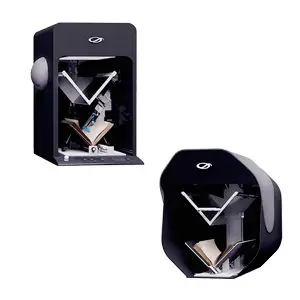Choosing the Right Book Scanning Method

Books are one of the oldest and most enduring forms of communication and keepsakes of cultural tradition. Whether they contain fiction, history, how-to guides or clerical information and whether they are kept in a library, archive, records room or other repository, books are a vital resource containing a vast array of knowledge. With the world quickly going digital and rare or fragile material fading with time, it is a constant effort to make this knowledge available for future generations. Enter book digitization.
Ideal for both archival preservation and information sharing, there are many points to consider when deciding the best way to capture book images. These include:
Outsourcing vs. Scanning In-house
Typically, the first question is whether to purchase a book scanner and manage the project in-house or outsource the work to a service bureau, such as Crowley Imaging. For purchase, budget considerations include scanner and maintenance costs and consumables, potential repair costs, scanning and processing software, training time, operator and other wages, media transportation (if required) and collection storage (if required). For outsourcing, costs will include media transportation, scanning and processing labor and the final deliverables (ie: hard drive). For both methods, considerations include compatibility with the intended IT infrastructure and long-term digital media storage. The volume of the digitization and/or the special needs of the collection (ie: archival handling/preservation) are often the keys to determining cost-efficiency factors in purchase vs. outsource.
Destructive vs. Non-destructive Scanning
If a book is in fair condition and it’s not necessary to keep the material in its original format, it can be dissembled (the binding is removed but the pages are preserved) and fed through a rotary scanner such as the InoTec 400-series production-level document scanner or the soon-to-be-released 800-series ultra-high-performance scanner. This allows for faster turn-around time and often lower costs.
If the books are rare, valuable or fragile, then non-destructive methods are best. This means that the books are scanned with the bindings still attached. If bound-book scanning is required, there are further considerations.
Image Quality and Resolution (Flatbed vs. Planetary Scanners)
In the imaging world, there are thought to be eight parameters which determine image quality: geometry and distortion; channel registration; noise; linearity; dynamic range; color accuracy; homogeneity (illumination) and resolution. In a previous blog, we thoroughly discussed resolution, which is often misunderstood and is far more complex than dpi (dots per inch) or ppi (pixels per inch). Says Patrice Letailleur of Zeutschel and author of that post, “The primary point is that resolution (dpi/ppi) is just a part of the capture equation. When you are making a decision as to the best output, you must consider all eight parameters. This includes considering the capabilities of the scanners to be purchased or used on your imaging project.” Scanners are often generalized into two types based on their function within these parameters: flatbed and overhead/planetary scanners (referred to below as book scanners). Letailleur gives a short overview of the benefits of each:
- Flatbed Scanners: Flatbed scanners produce good quality at a reasonable price. The paper is near the camera, light is controlled and outside light is usually not an influence. However, these scanners are not ideal for books, maps or old and precious documents, which may be fragile or light-sensitive. In these instances, you should choose a higher-end book scanner.
- Book Scanners: Archival book scanners have their capturing module placed in a head that is far away from the document to be captured (thus the term, “planetary scanner”). This is ideal for older and precious documents and books, but does create challenges in terms of image quality. The surrounding environment can influence the quality of the document captured.
Flatbed scanners are often branded as best fit for on-demand uses such as libraries or offices requiring low-volume copy/scan capabilities. Planetary scanners are typified for use in back-office service bureau operations for digitizing large collections. However, certain planetary scanners, like the compact overhead Zeutschel zeta patron scanner, are specifically designed for on-demand use and produce better quality images than most flatbed scanners.
V-shaped vs. 180-degree Book Cradles
For very fragile bound books, scanners with a V-shaped cradle, such as the Qidenus 3.0 series which only requires the book to lay open at 80-100⁰, are often thought to be the safest way to scan. In the Qidenus, the smaller opening angle reduces pressure on the spine while still allowing high-quality images to be captured using two overhead cameras.
Scanners which allow the book to be opened to 180⁰, such as the Zeutschel 12002 and 14000-series, “are delivered with a flexible cradle that also reduces spine stress. Zeutschel offers offers additional book cradles and holders options. Adjustable book cradles (such as on the Zeutschel 15000-series) adjust to the weight of the book so that the spine is at an angle but the pages lay flat. Laying the book open to 180⁰ allows a single overhead camera to capture an image of both pages at a time, which can be edited as separate images in processing, to save time during the scanning process.
Glass plate vs. No glass plate
A glass plate (also called a platen) can be placed over the pages to smooth out any curves which may distort an image. If a book is too fragile to come into contact with the glass plate, curves can also be removed from the images during processing using software such as Zeutschel’s Perfect Book 3D technology with automatic curve correction and deskew.
Interested in Book Digitization?
If you have a large volume of bound books to digitize, please contact our hardware or imaging representatives to find out if we might be of service or call (240) 215-0224. General inquiries can be emailed to [email protected]. You can also follow The Crowley Company on Facebook, Twitter, Google+, LinkedIn, Pinterest, and YouTube.
